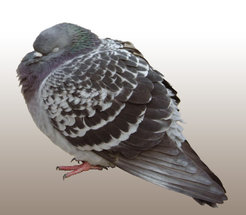"Power napping" in pigeons
Pigeons prevented from taking naps in the afternoon sleep more intensely at night
In humans, as in all mammals, sleep consists of two phases: deep, dreamless slow-wave-sleep (SWS) alternates with dream phases, called Rapid Eye Movement (REM)-sleep. Although several studies suggest that information is processed and memories are consolidated during sleep, this remains a hotly debated topic in neurobiology. Comparative studies in birds may help to clarify the function of sleep by revealing overriding principles that would otherwise remain obscure if we only studied mammals. This is because birds are the only taxonomic group other than mammals to show both SWS and REM sleep. Interestingly, the independent evolution of similar sleep states in birds and mammals might be related to the fact that each group also independently evolved large brains capable of performing complex cognitive processes. In their actual study, researchers from the Max-Planck Institute of Ornithology in Seewiesen, Germany showed for the first time that birds compensate for sleep loss in a manner similar to humans (Journal of Sleep Research, Online-Publication February 27, 2008).

During SWS, the synchronous, slow oscillations of neurons are reflected in the EEG (Electroencephalogram), as large slow-waves with a frequency of less than 4 Hz, hence the name slow-wave sleep. The amount of slow-waves is positively correlated with the depth of sleep, and may reflect restorative processes occurring during sleep. Indeed, humans, and other mammals, recover from periods of sleep loss, primarily by increasing the amount of slow-waves, particularly during the first hours of SWS, in essence sleeping more intensely. Although birds also show SWS, it has been unclear whether they show a similar response to sleep loss. Dolores Martinez-Gonzalez and colleagues at the Max Planck Institute for Ornithology in Seewiesen found now, that birds - in this case pigeons - also do not simply shrug of sleep loss.
In their study, the sleep researchers prevented pigeons from taking naps, something they generally do during the last hours of a day. During the night, the birds were allowed to sleep normally. Although the time spent in SWS did not increase during recovery, the amount of slow-waves did increase, just as in mammals. This means that pigeons, and presumably other birds, have the capacity to recover lost sleep without having to spend more time sleeping. "If pigeons lose sleep when a predator is around, they can recover this lost sleep at a later time by sleeping more deeply. This intensity dimension to avian and mammalian sleep may give animals a certain degree of flexibility in how they acquire their daily sleep requirement", says Niels Rattenborg, co-author of the study and head of the research group Sleep and flight in birds at the Institute.
The way sleep is regulated in birds and mammals seems to be more similar than previously thought. This increases the chances of learning more about the function of sleep in humans by studying sleep in birds.












